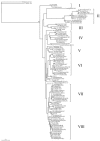Sequence diversity of the Bacillus thuringiensis and B. cereus sensu lato flagellin (H antigen) protein: comparison with H serotype diversity
- PMID: 16820457
- PMCID: PMC1489342
- DOI: 10.1128/AEM.00328-06
Sequence diversity of the Bacillus thuringiensis and B. cereus sensu lato flagellin (H antigen) protein: comparison with H serotype diversity
Abstract
We set out to analyze the sequence diversity of the Bacillus thuringiensis flagellin (H antigen [Hag]) protein and compare it with H serotype diversity. Some other Bacillus cereus sensu lato species and strains were added for comparison. The internal sequences of the flagellin (hag) alleles from 80 Bacillus thuringiensis strains and 16 strains from the B. cereus sensu lato group were amplified and cloned, and their nucleotide sequences were determined and translated into amino acids. The flagellin allele nucleotide sequences for 10 additional strains were retrieved from GenBank for a total of 106 Bacillus species and strains used in this study. These included 82 B. thuringiensis strains from 67 H serotypes, 5 B. cereus strains, 3 Bacillus anthracis strains, 3 Bacillus mycoides strains, 11 Bacillus weihenstephanensis strains, 1 Bacillus halodurans strain, and 1 Bacillus subtilis strain. The first 111 and the last 66 amino acids were conserved. They were referred to as the C1 and C2 regions, respectively. The central region, however, was highly variable and is referred to as the V region. Two bootstrapped neighbor-joining trees were generated: a first one from the alignment of the translated amino acid sequences of the amplified internal sequences of the hag alleles and a second one from the alignment of the V region amino acid sequences, respectively. Of the eight clusters revealed in the tree inferred from the entire C1-V-C2 region amino acid sequences, seven were present in corresponding clusters in the tree inferred from the V region amino acid sequences. With regard to B. thuringiensis, in most cases, different serovars had different flagellin amino acid sequences, as might have been expected. Surprisingly, however, some different B. thuringiensis serovars shared identical flagellin amino acid sequences. Likewise, serovars from the same H serotypes were most often found clustered together, with exceptions. Indeed, some serovars from the same H serotype carried flagellins with sufficiently different amino acid sequences as to be located on distant clusters. Species-wise, B. halodurans, B. subtilis, and B. anthracis formed specific branches, whereas the other four species, all in the B. cereus sensu lato group, B. mycoides, B. weihenstephanensis, B. cereus, and B. thuringiensis, did not form four specific clusters as might have been expected. Rather, strains from any of these four species were placed side by side with strains from the other species. In the B. cereus sensu lato group, B. anthracis excepted, the distribution of strains was not species specific.
Figures




References
-
- Claus, D., and R. C. W. Berkeley. 1986. The genus Bacillus, p. 1105-1139. In P. H. A. Sneath, N. S. Mair, M. E. Sharpe, and J. G. Holt (ed.), Bergey's manual of systematic bacteriology, vol. 2. Williams & Wilkins, Baltimore, Md.
-
- de Barjac, H., and A. Bonnefoi. 1962. Essai de classification biochimique et sérologique de 24 souches de Bacillus du type B. thuringiensis. Entomophaga 7:5-31.
-
- Entomogenous Organism Research Group. 1976. Bacillus thuringiensis “140,” a new variety without flagellum. Acta Microbiol. Sin. 16:12-16.
-
- Glare, T. R., and M. O'Callaghan. 2000. Bacillus thuringiensis: biology, ecology and safety. John Wiley & Sons, Ltd., Toronto, Canada.
MeSH terms
Substances
Associated data
- Actions
- Actions
- Actions
- Actions
- Actions
- Actions
- Actions
- Actions
- Actions
- Actions
- Actions
- Actions
- Actions
- Actions
- Actions
- Actions
- Actions
- Actions
- Actions
- Actions
- Actions
- Actions
- Actions
- Actions
- Actions
- Actions
- Actions
- Actions
- Actions
- Actions
- Actions
- Actions
- Actions
- Actions
- Actions
- Actions
- Actions
- Actions
- Actions
- Actions
- Actions
- Actions
- Actions
- Actions
- Actions
- Actions
- Actions
- Actions
- Actions
- Actions
- Actions
- Actions
- Actions
- Actions
- Actions
- Actions
- Actions
- Actions
- Actions
- Actions
- Actions
- Actions
- Actions
- Actions
- Actions
- Actions
- Actions
- Actions
- Actions
- Actions
- Actions
- Actions
- Actions
- Actions
- Actions
- Actions
- Actions
- Actions
- Actions
- Actions
- Actions
- Actions
- Actions
- Actions
- Actions
- Actions
- Actions
- Actions
- Actions
- Actions
- Actions
- Actions
- Actions
- Actions
- Actions
- Actions
LinkOut - more resources
Full Text Sources
Other Literature Sources
Molecular Biology Databases
Miscellaneous

